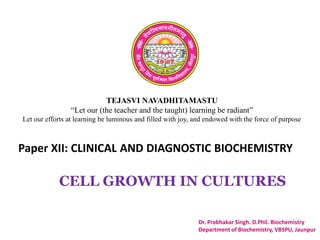
Prabhakar Singh- IV_SEM-CELL GROWTH IN CULTURES
- 1. TEJASVI NAVADHITAMASTU “Let our (the teacher and the taught) learning be radiant” Let our efforts at learning be luminous and filled with joy, and endowed with the force of purpose Paper XII: CLINICAL AND DIAGNOSTIC BIOCHEMISTRY Dr. Prabhakar Singh. D.Phil. Biochemistry Department of Biochemistry, VBSPU, Jaunpur CELL GROWTH IN CULTURES
- 2. GROWTH CYCLE OF CULTURED CELLS: The growth cycle of cultured cells is represented by three phases — the lag phase, the log (exponential) phase and the plateau phase The lag phase: The lag phase represents a period of adaptation during which the cell forms the cell surface and extracellular matrix (lost during trypsinization), attaches to the substrate and spreads out. There is an increased synthesis of certain enzymes (e.g. DNA polymerase) and structural proteins, preparing the cells for proliferation. The production of specialized products disappears which may not reappear until the cell proliferation ceases. The lag phase represents preparative stage of the cells for proliferation following subculture and reseeding. The plateau phase: As the cells reach confluence, the growth rate is much reduced, and the proliferation of cultured cells almost stops. This stage represents plateau or stationary phase, and is characterized by: a. Low motility of cells. b. Reduced ruffling of plasma membrane. c. Cells occupying minimum surface area. d. Contact inhibition. e. Saturation density. f. Depletion of nutrients and growth factors. g. Reduced synthesis of structural proteins. h. Increased formation of specialized products. The log phase: The log phase is characterized by an exponential growth of cells, following the lag phase. During the log phase, the cultured cells are in the most uniform and reproducible state with high viability. This is an ideal time for sampling. The log phase terminates after confluence is reached with an addition of one or two population doublings. The duration of log phase depends on the cells with reference to: a. Seeding density. b. Growth rate. c. Density after proliferation.
- 3. PLATING EFFICIENCY OF CULTURED CELLS 1. Plating efficiency, representing colony formation at low cell density, is a measure used for analyzing cell proliferation and survival. 2. When the cells, at low densities, are cultured in the form of single cell suspensions, they grow as discrete colonies. Plating efficiency is calculated as follows. 3. Plating efficiency = No. of colonies formed/No. of cells seeded × 100 4. The term cloning efficiency is used (instead of plating efficiency) when each colony grows from a single cell. 5. Seeding efficiency representing the survival of cells at higher densities is calculated as follows. Seeding efficiency = No. of cells recovered/No. of cells seeded × 100 Cell Synchronization: Synchronization literally means to make two or more things happen exactly simultaneously. For instance, two or more watches can be synchronized to show exactly the same time. The cells at different stages of the cell cycle in a culture can be synchronized so that the cells will be at the same phase. Cell synchrony is required to study the progression of cells through cell cycle. Several laboratory techniques have been developed to achieve cell synchronization. Some Highlights of Cell Synchronization: 1. Cell separation by physical methods is more effective than chemical procedures. 2. Chemical blockade is often toxic to the cells. 3. Transformed cells cannot be synchronized by nutritional deprivation. 4. A high degree of cell synchrony (>80%) can be obtained in the first cycle, and in the second cycle it would be <60%. The cell distribution may occur randomly in the third cycle. Cellular Senescence: The growth of the cells is usually measured as population doublings (PDs). The PDs refer to the number of times the cell population doubles in number during the period of culture and is calculated by the following formula. Log10 (No. of cells harvested) – log10 (No. of cells seeded)/ log102 The phenomenon of senescence has been mostly studied with human fibroblast cultures. After 30-60 populations doublings, the culture is mainly composed of senescent fibroblasts. These senescent fibroblast are unable to divide in response to mitotic stimuli. It must be noted that the cells do not appear suddenly, but they gradually accumulate and increase in number during the life span of the culture.
- 4. MEASUREMENT OF CELL GROWTH IN CULTURES a. Direct measure of cell number. b. Determination of DNA/RNA content. c. Estimation of protein/ATP concentration MEASUREMENT OF SENESCENCE a. Loss of metabolic activity b. Lack of labeled precursor (3H-thymidine) incorporation into DNA. c. Certain histochemical techniques. SENESCENCE-ASSOCIATED Β-GALACTOSIDASE ACTIVITY ASSAY There occurs an overexpression of the lysosomal enzyme β-galactosidase at senescence. This enzyme elevation is also associated with an increase in the cell size as the cell enters a permanent non-dividing state. The number of senescent cells in a culture can be measured by senescence-associated β- galactosidase (SA-β) assay.
